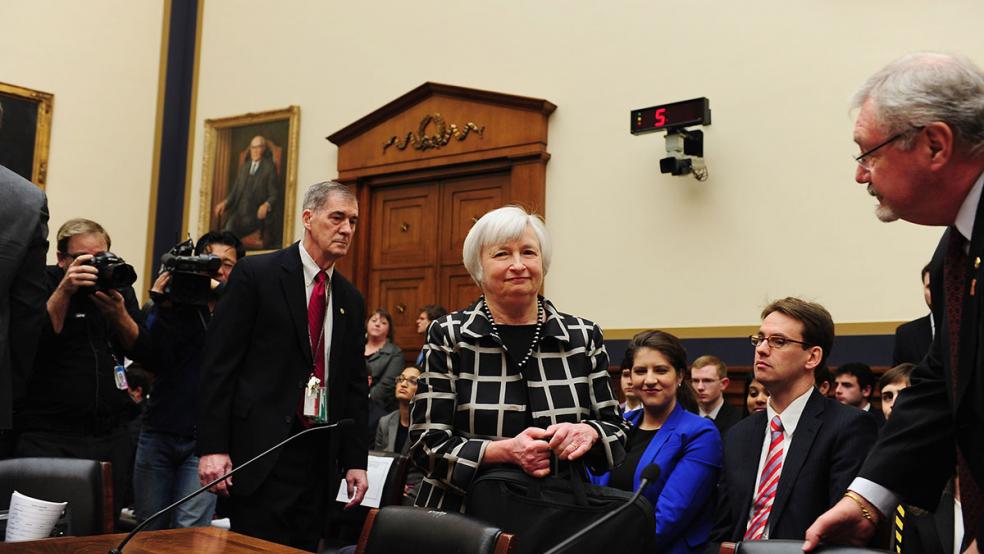Federal Reserve Board governor Jeremy Stein announced that he is stepping down at the end of May. That could leave the Board of Governors severely short-handed. Presently, three of the seven positions on the Board are open. There are nominations for two of the open positions, and the nominees, Stanley Fischer and Lael Brainard, await Senate confirmation. However, President Obama has not yet nominated anyone to fill the third open seat, and if Senate confirmation for Fischer and Brainard does not occur before June, then only three of the seven Board positions will be filled.
That will alter the balance of power on the committee responsible for setting monetary policy, the all-important Federal Open Market Committee. Normally, the twelve member FOMC is comprised of the seven members of the Board of Governors, the president of the NY Fed (where open market operations are conducted), and four seats that rotate annually among the other eleven regional Fed presidents.
Related: Yellen Plays Politician to Defend Fed Independence
Thus, if the Governors are united and the Board is fully staffed, Board members can dominate monetary policy decisions 7-5. But currently it is 4-5 in favor of the regional Fed banks, and it could move to 3-5 in favor of the regional Fed banks if Brainard and Fischer are not confirmed soon. Even if the Senate does confirm the two nominees, there will be a fairly substantial period of time when the split is 5-5.
That may or may not be a good thing from a policy perspective, it depends upon the make-up of the two groups and how the power shift alters policy choices. But it is certainly not what was intended when the Federal Reserve System was constructed.
One problem in filling the open positions on the Federal Reserve Board is that nominations have been blocked in the Senate, and Republicans have been particularly obstructionist. What is the reason for this?
In addition to the desire to block whatever this president tries to do as a way of obtaining political advantage, there are two factors that have helped to motivate the obstructionist tendencies.
Related: Why Citi’s Flunked Stress Test is So Troubling
First, the average term of individual Governors is becoming shorter. For example, “Average terms for 67 Fed governors appointed before Greenspan: 7.2 years. Since then: 4.8 years. Last 10 governors: 4.4 years.” The short-terms and high turnover rate among Federal Reserve governors has allowed both George Bush and Barack Obama to appoint the entire Board. That is not how the systems is designed to operate. Ideally, if Governors serve out their full 14-year terms, a new Governor will be appointed every other January. Thus, in an 8-year term a president could only appoint four of the seven members. That is intended to give the Board independence, stability, continuity, and political balance.
The last factor, political balance, is important in understanding obstructionism. When there is high turnover and one president can appoint the entire Board, it is much more likely that Senators will insist upon political balance. When there are two appointments, for example, the opposition may do its best to block the confirmation process unless one of the nominees is sympathetic to its point of view. So the failure of Governors to serve anything close to full 14 year terms – Jeremy Stein’s term is one of the shortest on record – is a factor in political gridlock.
The second factor is the split within the economics profession about the best way to conduct monetary policy, a split that could have large consequences. One side – mostly Republicans – believes that inflation is threatening even though there are no signs of an inflation problem in current data. This group would raise interest rates pre-emptively in response to their inflation fears even if it slows the growth of employment. The other side – mostly Democrats – believes that unemployment is a much bigger worry than inflation and would prefer to keep interest rates low, at least for now.
Related: More Wall Street Economists See Rate Hike in First Half 2015
If the inflation hawks are wrong, and I think they are, we will have sacrificed jobs for no good reason – it would be a war against inflation that does not need to be waged. If, on the other hand, those who think we can do more to fight unemployment without risking inflation are wrong, we could end up with an inflation problem.
The composition of the Federal Reserve Board would not matter so much if there wasn’t such a big split among economists about monetary policy – a split that divides largely along political lines. But as it stands, the composition of the Board of Governors is hugely important, and a source of heated political battles and obstructionist behavior.
Because of these battles, since the start of our economic troubles in 2007 the Federal Reserve Board has only had seven members 20 percent of the time, and for more than half of that time period only five of seven positions were filled. That is unacceptable. We needed the Fed to be fully staffed and performing at its very best; instead, political battles left it short-handed at a critical time.
Unfortunately, so long as the economics profession remains divided on the best course for monetary policy – and it’s hard to see that changing anytime soon – the political battles are likely to persist. But it is possible for Board members to pledge to serve full terms when they accept the job, or at least serve much longer terms than the current average. That would make it harder for a president to have a large impact on the composition of the Board, and make it less likely that a nominee will be blocked.
Top Reads from The Fiscal Times:






